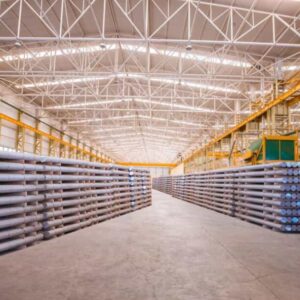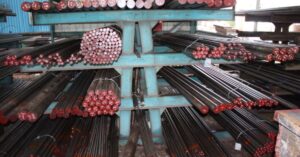Tool Steel’s Enduring Influence on Defense Applications
Introduction
Tool steel refers to a versatile family of ultra-hardenable steels optimized for use in high-performance tools and components. Thanks to its exceptional properties like hardness, strength, and temperature resistance, tool steel has become indispensable in countless defense applications for ensuring reliability, safety, and effectiveness under extreme conditions. This article explores tool steel’s unique capabilities, its vital current uses across military systems, the latest tool steel innovations influencing defense technologies, and recommendations to leverage tool steel most strategically.
Overview of Tool Steel Properties
 Tool steels achieve remarkable performance capabilities tailored to demanding applications through careful metallurgical engineering:
Tool steels achieve remarkable performance capabilities tailored to demanding applications through careful metallurgical engineering:
Alloying Elements
Added amounts of nickel, chromium, tungsten, vanadium, cobalt, and other elements impart optimized mechanical, thermal, and chemical properties in tool steels.
Heat Treatment
Precise heating and cooling thermal processing develops desired microstructures and transforms tool steel into much harder phases like martensite.
Exceptional Properties:
- Extreme hardness (HRC 60+) for wear resistance
- High strength and fracture toughness
- Excellent dimensional stability and durability
- Resistance to high temps and thermal fatigue
- Corrosion resistance in harsh environments
Diverse Grades
Many standardized tool steel grades exist, each optimized for requirements ranging from maximum hardness or strength to machinability or hot hardness.
These properties make tool steel an ideal problem-solving material for defense systems facing extreme demands.
Vital Uses of Tool Steel in Defense
Tool steel currently serves irreplaceable roles across diverse defense technologies and systems:
Firearm Components
The slides, barrels, chambers, triggers, ejectors, and firing pins of pistols and rifles rely on tool steels for hardness, fatigue life, and dimensional precision.
Missile and Rocket Hardware
Turbopumps, valve components, fasteners, combustion chamber parts, and nozzles depend on tool steel alloys for high-temperature strength.
Armored Vehicle Elements
Gun barrels, turret rings, drivetrain gears, torsion bars, and armored exterior plates leverage tool steel for hardness and ballistic protection.
Aircraft and Jet Engine Parts
Landing gears, rotors, engine turbine blades, exhaust parts, drivetrain components utilize tool steel’s heat and fatigue resistance.
Cutting, Shaping, and Finishing Tools
Machining tools, abrasive grinding wheels and belts, and polishing media made with tool steel maintain precision cutting ability through extensive use machining defense hardware.
Testing Equipment
Load frames, high strain pins and fasteners, custom fixtures, and other lab testing equipment take advantage of tool steel’s hardness, stiffness, and machinability.
Tool steel provides an essential material foundation enabling reliable, durable, and high-performance defense systems across air, ground, and sea applications where failure is not an option.
Tool Steel Application Areas in Defense
Some key areas using tool steels across military systems include:
Ballistics Protection
Vehicle armor plates, bulletproof glass laminates, helmets, and shields depend on tool steel for hardness and impact energy absorption to provide life-saving ballistic protection.
Critical Drivetrain Components
Gun turret drive gears, helicopter transmissions, heavy vehicle differentials, propeller shafts, and jet engine rotors rely on tool steel for the ultimate in fatigue life and fracture resistance.
Explosives Fabrication and Handling
Tool steel plays a vital role in fabrication equipment handling extremely dangerous explosive materials as well as ordnance storage containers, transport carts, and mounting hardware where unintended detonation cannot be risked.
High-Performance Projectiles
From small arms bullets to missile casings to tank penetrators, tool steel provides the tailored hardness, density, and ballistic properties demanded in armor-piercing and low-signature projectiles.
Extreme Environment Hardware
Fasteners, valves, pumps, and other components made from tool steel withstand the high pressures, temperatures, and corrosive conditions found in submarines, hypersonic engines, and re-entry vehicles.
Critical Safety Elements
Pin and shoulder bolts, breechblock firing components, retaining rings, ejectors, and other firearm safety mechanisms rely on tool steel for strength, precision, and reliable performance.
Tool steel delivers essential capabilities across this diverse range of defense applications where failure or malfunction poses unacceptable risks to equipment, personnel, and missions.
Innovations in Tool Steel for Defense
Continuing tool steel research and product developments promise expanded capabilities and benefits:
Additive Manufacturing
3D printing of tool steel enables complex consolidated components with densities and material properties equaling traditionally processed tool steel.
Composite Reinforcement
Dispersing nano-scale reinforcing particles forms tool steel matrix composites boasting enhanced strength, hardness, and temperature resistance.
Advanced Surface Engineering
Next-generation coatings like microtubular carbides, graphene, diamond-like carbon, and nanolaminates create revolutionary low-friction, wear-resistant tool steel surfaces.
Custom Alloy Design
High-throughput computational and experimental alloy development techniques facilitate rapid design of application-specific tool steel grades unlike anything available today.
Embedded Sensors
Microsensors integrated directly into bulk tool steel parts and coatings provide real-time diagnostics on strain, temperature, corrosion, and micro-defects enabling condition-based maintenance.
Leveraging these kinds of disruptive tool steel innovations will drive step-change improvements in military equipment field readiness, lifetime, and performance.
Strategic Importance of Tool Steel for Defense
There are compelling reasons why tool steel holds strategic importance for defense:
Specialty Grade Availability
Domestic availability of specialized high-performance tool steel grades and processing capacity ensures supply chain integrity for defense contractors and arsenals.
Self-Sufficiency
In-house tool steel recycling capabilities at defense facilities conserve materials and ensure flexible component production capabilities independent of external supply situations.
Design Freedom
The vast possibilities for modifying and customizing tool steel alloy, process, and properties provide unmatched design flexibility for creating application-specific solutions.
Risk Reduction
The proven pedigree of tool steel performance in the most extreme and demanding defense applications minimizes uncertainty when adopting it in new critical uses.
Future Capabilities
Ongoing tool steel advancements will continue providing revolutionary materials solutions far into the future that would be impossible with other material classes like composites or ceramics.
Maintaining leadership in tool steel innovation, processing know-how, and manufacturing capabilities is in the national defense interest of industrialized nations across the world.
Challenges With Tool Steels for Defense
However, there are inherent challenges that must be overcome to maximize the value of tool steel for defense:
Processing Limitations
Achieving tight dimensional tolerances, acceptable surface finish, and complex geometries can be more difficult with tool steel compared to other structural metals.
Composition Data Restrictions
Stringent data restrictions on composition details and processing methods for advanced proprietary tool steel grades can hinder third-party component production.
Design Experience Barriers
Insufficient materials design experience and performance data for new tool steel grades among contractors and engineers slows qualification and adoption of the latest high-performance alloys.
Sustainment Difficulties
Maintaining adequate life cycle inventories of spare parts and components across decades with evolving tool steel grades poses logistical difficulties for defense sustainment.
Counterfeit Vulnerability
Complex alloy-specific heat treatments make tool steel particularly vulnerable to compromised mechanical properties if counterfeit substitution occurs in the supply chain.
Cyber Supply Chain Threats
Increasing reliance on digital tool steel inventory data heightens vulnerability to cyberattack-caused production and sustainment disruptions.
A collaborative effort across suppliers, contractors, officials, and engineering specialists is needed to actively address these hurdles.
Strategic Recommendations for Tool Steel in Defense
 To leverage tool steel most effectively for defense applications, strategic recommendations include:
To leverage tool steel most effectively for defense applications, strategic recommendations include:
- Maintain specialized domestic tool steel production and processing capacity for critical grade availability.
- Prioritize repair and reuse initiatives and onsite recycling efforts to ensure flexible, resilient supply capabilities.
- Fund research consortia to rapidly develop, test, and qualify advanced tool steel grades tailored for next-generation defense applications.
- Establish comprehensive tool steel use databases and digital twins to optimize component lifecycles and enable predictive maintenance.
- Require full traceability of testing data and processing details for all grades to enhance anti-counterfeiting.
- Provide logistical, technical, and financial assistance to allies to develop indigenous tool steel capabilities boosting collective supply chain security.
- Utilize embedded unique material signatures and blockchain tracking for high-security tool steel parts and data authentication.
- Implement rigorous cyber safeguards for tool steel inventory systems and production infrastructure.
With coordinated action in these areas, tool steel can continue providing unique advantages securing defense superiority, efficiency, and safety long into the future.
Conclusion
In conclusion, tool steel possesses optimized properties like hardness, strength, and temperature resistance that make it an essential problem-solving material across innumerable critical defense applications—from firearms to jet engines to armor systems. Ongoing innovations promise to unlock even greater capabilities for using tool steel in creative new ways to enhance military technology. To maximize national security advantages, strategic steps must safeguard reliable domestic supply and processing competence for high-performance tool steel grades. With sound strategy, tool steel will continue serving vital roles across defense systems, supporting effectiveness, self-sufficiency, flexibility, and technical superiority through whatever challenges the future holds.
Frequently Asked Questions on Tool Steel for Defense
What makes tool steel suited for firearms?
Tool steel provides the hardness, dimensional precision, surface finish, fatigue strength, and corrosion resistance required for reliable functioning and accuracy in firearm slides, barrels, chambers, triggers, pins, and other critical components.
Why is tool steel used in aerospace applications?
Aerospace systems demand materials that withstand high operating temperatures and centrifugal forces. Tool steel maintains its strength, creep resistance, and fracture toughness at elevated temperatures essential for jet engine and airframe parts enduring severe conditions.
How does tool steel protect against ballistic threats?
Tool steel achieves the optimized combination of hardness and impact toughness required to resist penetration and absorb the energy of bullets or shrapnel without catastrophic failure, making it ideal for vehicle and personnel armor.
How could metal matrix composites improve tool steel performance?
Reinforcing tool steel with nanoparticles forms composites that exhibit superior mechanical properties. For defense uses, this could provide enhanced strength for lighter weight armor or better high-temperature properties for hypersonic engines.
How will additive manufacturing impact tool steel use?
3D printing complex one-piece tool steel components improves performance through consolidation while enabling designs unattainable by other methods. This expands tool steel applications across defense systems.
Why is tool steel recycling important for defense?
In-house tool steel recycling provides flexible, resilient component production capabilities independent of supply chain disruptions critical for national defense self-sufficiency. This insulation from external shocks is a strategic advantage.
How can embedded sensors improve tool steel components?
Integrated microsensors provide real-time data on strain, temperature, corrosion, and micro-defect progression during service. This health monitoring enables condition-based maintenance maximizing component lifetimes.

